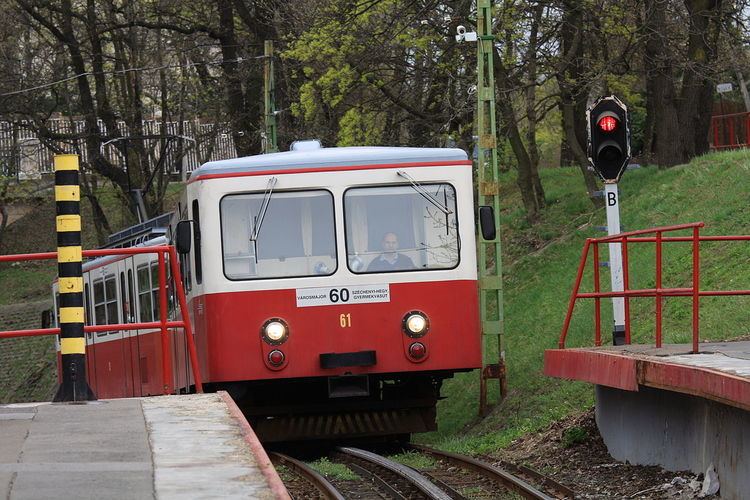Native name Fogaskerekű Electrification 1500 V DC Phone +36 1 258 4636 | Line length 3.7 km (2.3 mi) Rack system Strub Line number 60 | |
 | ||
Track gauge 1,435 mm (4 ft 8 ⁄2 in) Operating speed Similar Libegő, Városmajor, Normafa, Széchenyi‑hegy, Hegyvidék | ||
Budapest cog wheel railway
The Budapest Cog-wheel Railway, officially called Tram line number 60, is a rack railway running in Budapest, Hungary.
Contents
- Budapest cog wheel railway
- Onboard the budapest cog wheel railway fogaskerek vas t budapest hungary
- History
- Future developments
- References
Onboard the budapest cog wheel railway fogaskerek vas t budapest hungary
History
Since 1868 a horse tramway ran on schedule from the Lánchíd to Zugliget set in operation by the Budai Közúti Vaspálya Társaság (~ Public Railway Society of Buda). Nikolaus Riggenbach (the designer of the first European cog-wheel train line of Vitznau-Rig opened in 1871) with a colleague of his as the representatives of the Internationale Gesellschaft für Bergbahnen applied for the construction of the cog-wheel train line leading to Svábhegy. The building permit was issued on July 3, 1873, and construction of the line began immediately, thus enabling the service to start up in the following year. The first introductory vehicle ran from 4 p.m. on June 24, 1874, and regular traffic began on the following day. The whole line was built according to Riggenbach's cog-wheel system. The normal-gauge single track railway was 2883 m (1.56 miles) long all the way uphill with a difference in height of 264 m. The terminal point was built at the present Városmajor.
Successful operation of the cog-wheel railway raised the issue of extending the line. The plan was brought to fruition in 1890, when traffic started to the Széchenyi Mountain increasing the length of the line to 3700 m. The municipal transportation company BSzKRt took over the railway in 1926. From July 2, 1929, the new electrically powered vehicles ran every 15 minutes. 1973 saw a full reconstruction, during which the whole track was renewed using the Strub cog-wheel system, and new vehicles introduced. The older trains last ran on 15 March 1973 and traffic using the new vehicles began on 20 August of the same year.
Hours of operation are 0500-2300 daily. The railway is part of Budapest's public transport system allowing standard tickets and passes to be used.
Future developments
The Urban and Suburban Transit Association (VEKE) is advocating that the line be extended in both directions (Normafa and Széll Kálmán tér).
